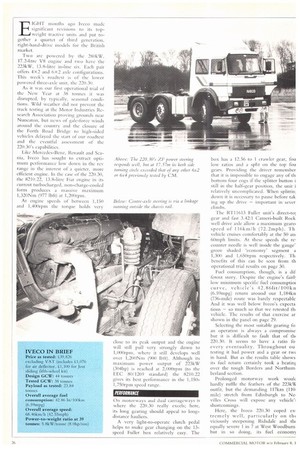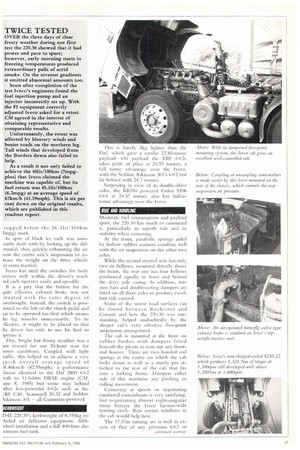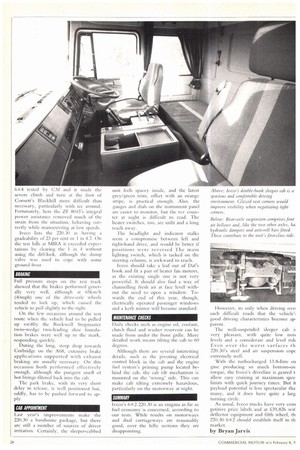4 F k months onths ago Iveco made
Page 26

Page 27

Page 28

If you've noticed an error in this article please click here to report it so we can fix it.
significant revisions to its topweight tractive units and put together a quartet of third generation, right-hand-drive models for the British market.
Two are powered by the 280kW, 17.2-litre V8 engine and two have the 223kW, 13.8-litre in-line six. Each pair offers 4x2 and 6x2 axle configurations. This week's roadtest is of the lower powered three-axle unit, the 220.30.
As it was our first operational trial of the New Year at 38 tonnes it was disrupted, by typically, seasonal condidons. Wild weather did not prevent the track testing at the Motor Industries Research Association proving grounds near Nuneaton, but news of gale-free winds around the country and the closure of the Forth Road Bridge to high-sided vehicles delayed the start of our roadtest and the eventful assessment of the 220.30's capabilities.
Like Mercedes-Benz, Renault and Scania, Iveco has sought to extract optimum performance low down in the rev range in the interest of a quieter, more efficient engine. In the case of the 220.30, the 8210.22, 13.8-litre Fiat engine in its current turbocharged, non-charge-cooled form produces a massive maximum 1,320Nm (977 Ibit) at 1,200rpm.
At engine speeds of between 1,150 and 1,400rpm the torque holds very close to its peak output and the engine will still pull very strongly down to 1,000rpm, where it still develops well over 1,200Nm (9(1) Ibti). Although its maximum power output of 223kW (304hp) is reached at 2,000rpm (to the EEC 80/1269 standard) the 8210.22 gives its best performance in the 1,1501,750rpm speed range.
PERFORMANCE On motorways and dual carriageways is where the 220.30 really excels; here, its long gearing should appeal to longdistance hauliers.
A very light-to-operate clutch pedal helps to make gear changing on the 13speed Fuller box relatively easy. The
box has a 12.56 to 1 crawler gear, fou low ratios and a split on the top Lou gears. Providing the driver remember that it is impossible to engage any of th bottom four cogs if the splitter button i still in the half-gear position, the unit i relatively uncomplicated. When splittin; down it is necessary to pause before tak ing up the drive — important in sever climbs.
The RT11613 Fuller unit's direct-toi gear and fast 3.42:1 Cameri-built Rock well drive axle allow a maximum gearo speed of 116km/h (72.2mph). Th vehicle cruises comfortably at the 50 am 60mph limits. At these speeds the re' counter needle is well inside the gauge' green shaded 'economy' segment a 1,300 and 1,65Orpni respectively. Th. benefits of this can be seen from th operational trial results on page 30.
Fuel consumption, though, is a dif ferent story. Despite the engine's flirt! low minimum specific fuel consumptiot curve, vehicle's 4 2.861it/10 Okn (6.59mpg) return around our 1,184kn (736-mile) route was barely respectable And it was well below Iveco's expecta tions — so much so that we retested th, vehicle. The results of that exercise ar shown in the panel on page 29.
Selecting the most suitable gearing fo an operation is always a compromise but it is difficult to fault that of thi 220.30. It seems to have a ratio fo every eventuality. Throughout ou testing it had power and a gear or twt in hand. But as the results table shows its fuel return certainly took a beating over the tough Borders and Northumberland section.
Prolonged motorway work woulc hardly ruffle the feathers of the 2230X outfit, but the demanding 117km (110. mile) stretch from Edinburgh to Ne. villes Cross will expose any vehicle': shortcomings.
Here, the Iveco 220.30 coped ex. tremely well, particularly on tht viciously steepening Ridsdale and thi equally severe 1 in 7 at West Woodburn hut in so doing, its fuel cconom)
,ropped below the 56.51it/1(0km 5mpg) mark.
In spite of black ice each was sumnarily dealt with by locking up the diferential, then quickly exhausting the air tom the centre axle's suspension to inrease the weight on the drive wheels or extra traction.
Iveco has sited the switches for both levices well within the driver's reach nd each operates easily and speedily.
It is a pity that the button for the pike effective exhaust brake was not ituated with the same degree of Orethought. Instead, the switch is posiioned to the left of the clutch pedal and Las to he operated toe-first which strains he leg muscles unnecessarily. To be .ffective, it ought to be placed so that he driver has only to use his heel to iperate it.
Dry, bright but frosty weather was a ust reward for our 24-hour wait for ietter conditions. Coupled with light raffle, this helped us to achieve a very luick overall average speed of i8.46kin/h (42.55mph), a performance tImost identical to the Daf 2800 6x2 with its 11.6-litre DKSE engine (CM, une 8, 1985) but some way behind idler less-powerful 6x2s such as the RI C40, Scamniell 20.32 and Seddon ktkinson 301 — all Cummins-powered.
ERG WEIGHT
[FIE 220.30's kerbweight of 8,155kg inluded air deflector equipment, fifthwheel installation and a full 400-litre aluninium fuel tank.
This is barely 5kg lighter than the Daf, which gave a similar 23.85-tonne payload. On payload the ERE 6x2s takes pride of place at 24.93 tonnes, a full tonne advantage over the Nem with the Seddon Atkinson 301's 6x2 not far behind with 24.7 tonnes.
Surprising in view of its double-drive axles, the RR340 powered Foden 5106 6x4 at 24.57 tonnes also has half-atonne advantage over the Iveco.
RIDE AND HANDLING Moderate fuel consumption and payload apart, the 220.30 has much to commend it, particularly its superb ride and its stability when cornering.
At the front, parabolic springs aided by hollow rubber assisters combine well with the air suspension on the other two axles.
While the second steered axle has only two air bellows, mounted directly above the beam, the rear one has limr bellows positioned equally in front and behind the drive axle casing. In addition, torsion bars and double-acting dampers are fitted on all three axles to produce excellent ride control.
Some of the worst road surfaces can be found between Rochester and Consett and here the 220.30 was outstanding, helped undoubtedly by the sleeper cab's very effective five-point suspension arrangement.
The cab is mounted at the front on rubber bushes with dampers fitted beneath the pivots to iron out any frontend bounce. There are two bonded coil springs at the centre on which the cab locks down as well as a sturdy pin attached to the rear of the cab that tits into a locking frame. Dampers either side of this minimise any pitching or rolling movement.
Cornering at speeds or negotiating cambered roundabouts is very satisfying, but negotiating almost right-angular turns betrays the lveco far-too-wide turning circle. Rear corner windows in the cab would help here.
The 17.57m turning arc is well in excess of that of any previous 6x2 or continued overleaf 6X4 tested by CM and it made the severe climb and turn at the foot of Consett's Blackhill more difficult than necessary, particularly with ice around. Fortunately, here the ZF 8043's integral power assistance removed much of the strain from the situation, behaving correctly while manoeuvring at low speeds.
lveco lists the 220.30 as having a gradeability of 23 per cent or 1 in 4.2. On the test hills at MIRA it exceeded expectations by clearing the 1 in 4 without using the diff-lock, although the dump valve was used to cope with some ground frost.
BRAKING Full pressure stops on the test track showed that the brakes performed generally very well, although at 65kni/h (40mph) one of the drive-axle wheels tended to lock up, which caused the vehicle to pull slightly to the right.
On the few occasions around the test route when the vehicle had to he pulled up swiftly the Rockwell Stopmaster twin-wedge two-leading shoe foundation brakes were well up to the mark, • responding quickly.
During the long, steep drop towards Corbridgc on the A68, extensive brake applications supported with exhaust braking are usually necessary. On this occasion both performed effectively enough, although the pungent smell or hot linings filtered back into the cab.
The park brake, with its very short delay in release, is well positioned but, oddly, has to be pushed forward to apply.
CAB APPOINTMENT Last year's improvements make the 220.30 a handsome package, but there are still a number of sources of driver irritation. Certainly, the sleeper-cabbed Unit feels spaccy inside, and the latest grey/green trim, offset with an orange stripe, is practical enough. Also, the gauges and dials on the instrument panel are easier to monitor, but the rev counter at night is difficult to read. The heater switches, too, arc unlit and a long reach away.
The headlight and indicator stalks seem a compromise between left and right-hand drive, and would be better if positions were reversed The main lighting switch, which is tacked on the steering column, is awkward to reach.
!Alec° should take a leaf out of Daf s book and tit a pair of heater fan motors, as the existing single one is not very powerful, it should also find a way of channelling fresh air at face level without the need to open a window. Towards the end of this year, though, electrically operated passenger windows and a kerb mirror will become standard.
MAINTENANCE CHECNS Daily checks such as engine oil, coolant, clutch fluid and washer reservoir can be made from under the front grille. More detailed work means tilting the cab to 60 degrees.
Although there are several interesting details, such as the pivoting electrical control block in the cab and the engine fuel system's priming pump located behind the cab, the cab tilt mechanism is mounted on the 'wrong' side. This can make cab tilting extremely hazardous, particularly on the motorway at night.
SUMMARY lveco's 6x2 220.30 is an enigma as far as fuel economy is concerned, according to our tests. While results on motorways and dual carriageways are reasonably good, over the hilly sections they. are disappointing. However, its only when driving ovei such difficult roads that the vehicle'! good driving characteristics become apparent.
The well-suspended sleeper cab very pleasant, with quite low nois levels and a considerate and level ride Even over the worst surfaces th 220.30's steel and air suspension cope extremely well.
With the turbocharged 13.8-litre en gine producing so much bottom-entorque, the Iveco's driveline is geared t• allow easy cruising at maximum spec. limits with quick journey times. But it payload potential is less spectacular tha: many, and it does have quite a larg turning circle.
As usual, Iveco trucks have very corn petitive price labels and at £39,826 witl deflector equipment and fifth wheel, th 220.30 6x2 should establish itself in th market.
by Bryan Jarvis




























































